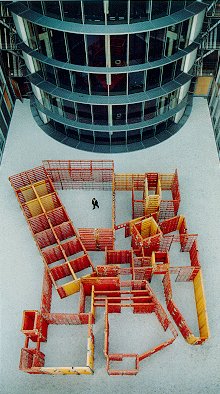Navigationspfad: Homepage > Art and History > Art > Artists > Franka Hörnschemeyer
Franka Hörnschemeyer: BFD - bündig fluchtend dicht

"BFD - bündig fluchtend dicht", Photo 1 © German Bundestag
Franka Hörnschemeyer (born 1958), "BFD - bündig fluchtend dicht" (flush aligned impervious), 1998 / 2001
Franka Hörnschemeyer has created a spatial sculpture composed of lattice walls for one of the courtyards on the northern side of the Paul Löbe Building. The red and black painted iron lattices are telescoped together to create an elaborate, filigree spatial labyrinth that takes up and reformulates the idea of a hedge maze in a garden setting. Five door-sized openings invite the viewer to enter this maze. There are paths that lead in and out, and spaces that can be crossed, but also dead ends and closed chambers. Thanks to its lattice structure, the spatial assembly looks light and transparent, and opens up numerous visual axes. In consequence, anyone who enters the maze never gets the feeling of being in a truly enclosed space.
The lattice walls are made up of formwork, the moulding that is used to build walls of poured concrete. The lattices are held together by assembly locks known to German construction engineers by the technical term BFD, which stands for ‘flush, aligned, impervious’. Elements that are normally used merely to construct walls have here themselves become the walls. The artist has removed the wooden panelling of the formwork so that only the metal lattice structure remains. The arrangement of the lattices is based on the ground plans of various buildings (past and present) in the area around the Spree Bend, including now demolished sections of the Berlin Wall to the east, buildings and dog kennels used by the GDR border guard that were once situated on the other side of the river, and parts of the Paul Löbe Building. Due to their axial displacement, the ground plans of the old and modern buildings interlock with each other at an angle - it could be said that they are clamped fatefully together. In this way, the past and the present are superimposed on each other, reflecting the area’s political development, which becomes tangible and comprehensible in the original sense of the words.
As the formwork elements are real construction materials, they initially remind the viewer of the process of building. This impression plays on the construction of the Paul Löbe Building and creates a contrast between the massive solidity of the Federal Chancellery and the Paul Löbe Building, and the charm of the transitory and the unfinished. Associations with climbing frames and playground equipment are also close at hand. In addition to this, however, the magical symbol of the labyrinth, which has a long tradition in Western mythology and art, throws up the question of how to find the right way, a question that, in a political space, is both playful and yet expresses serious intellectual concerns.
Hörnschemeyer was born in Osnabrück, and now lives and works in Berlin. In her sculptures she creates spatial assemblies that evoke architectural forms, often made of previously used building materials. It is possible to walk round and through these spatial sculptures, indeed, they can only be experienced fully in this way. The use of rough materials that still bear the traces of their processing and production is reminiscent of ready-mades, both drawing on the ideas of Arte povera and Minimalism, and at the same time putting them ironically in question.
Text: Andreas
Kaernbach,
Curator of the Art Collection of the German Bundestag

